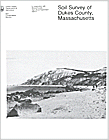The following map unit description is from the published "Soil Survey of Dukes County, Massachusetts"


Soil Survey of
Dukes County Massachusetts
The following map unit description is from the published "Soil
Survey of Dukes County, Massachusetts"


BeA-Berryland loamy sand, 0 to 2 percent slopes. This soil is very deep, nearly level, and very poorly drained. It is in closed depressions, at the base of swales, in low areas which border ponds and swamps, and in drainageways. The areas of this soil are throughout the survey area, are irregular in shape, and range from 3 to 25 acres. They make up about 1 percent of the survey area.
Typically the surface layer is black loamy sand about 5 inches thick. The subsurface layer is gray sand about 4 inches thick. The subsoil is sand about 23 inches thick. The upper 11 inches of the subsoil is very dark brown, the next 7 inches is mottled and dark gray, and the lower 5 inches is mottled and dark brown. The substratum is light brownish gray, mottled sand to a depth of 60 inches or more.
Included with this soil in mapping are a few small areas of Freetown, Swansea, and Pompton soils. Also included are soils that have firm to extremely firm layers in the subsoil. In some areas the subsoil and substratum have layers of silty clay or clay. Included areas make up about 25 percent of this unit.
The permeability of this Berryland soil is moderately rapid in the subsoil and moderately rapid or rapid in the substratum. Available water capacity is low. The soil has a seasonal high water table at or near the surface in the fall, winter, and spring. Water is ponded on the surface of some areas.
This soil is poorly suited to woodland productivity because of the seasonal high water table and a high rate of seedling mortality. Low strength of the soil limits the use of equipment to periods when the soil is dry or frozen. The common trees on this soil are red maple and tupelo.
The seasonal high water table makes this soil generally unsuitable for farming and is a major limitation for most types of nonfarm uses. The soil is well suited to use as wetland wildlife habitat. The native plant communities common to this soil provide adequate food and cover for wildlife nesting.
This unit is in capability subclass Vw.